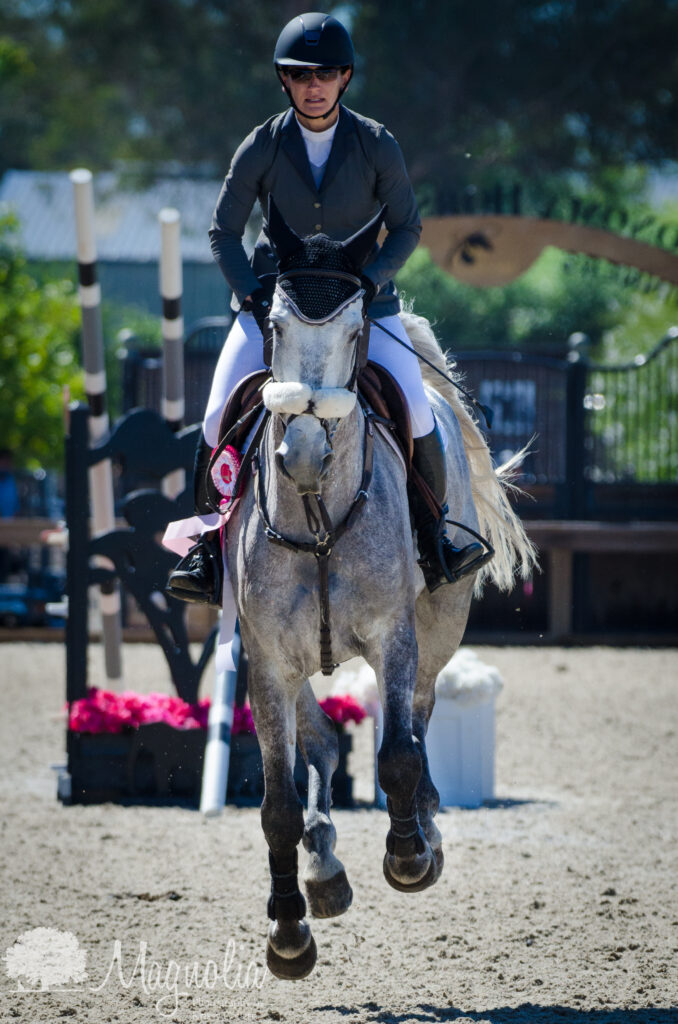Author: pbecadmin
Palm Beach Equine Clinic (PBEC) is one of the few equine hospitals in the country to have a full-time radiologist on-site during season. With the addition of Dr. Sarah Puchalski to their staff, as well as the installation of the most state-of-the-art imaging equipment, Palm Beach Equine Clinic has become a leader in diagnostic sport horse imaging.
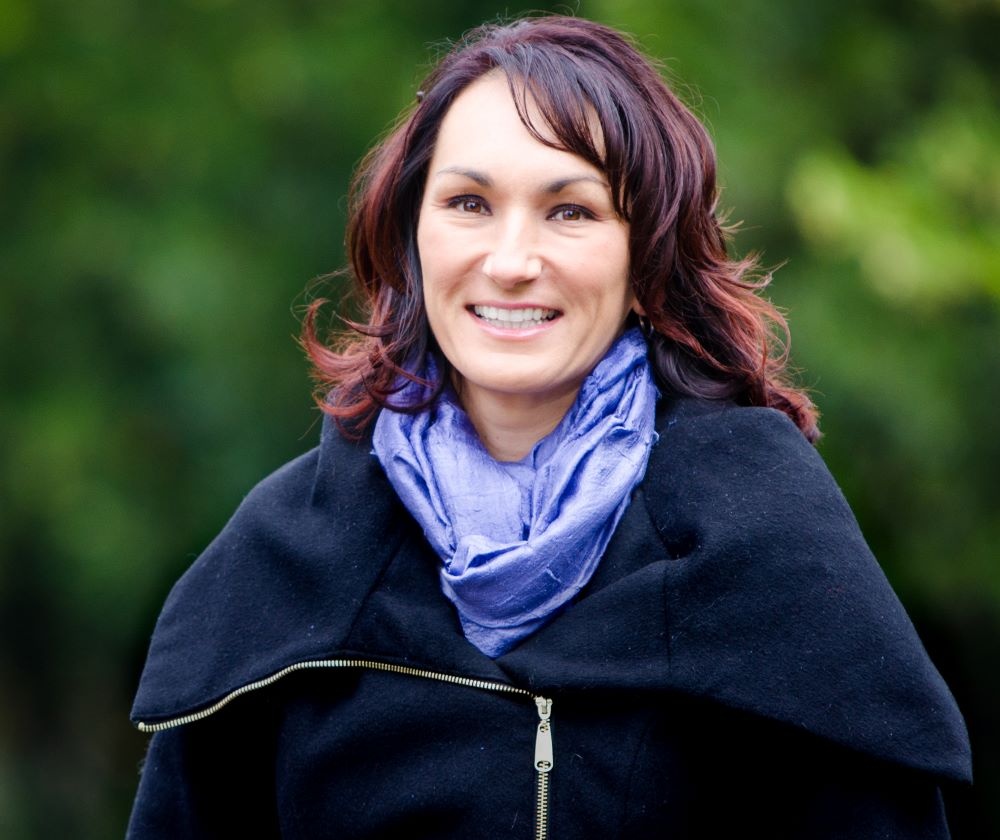
Dr. Puchalski is one of very few board-certified equine Radiologists in the country and one of the most high profile of those in the world. Early in her career, Dr. Puchalski earned the respect of the best in the industry and strives to continue to contribute advances for equine sports medicine and diagnostic imaging.
Dr. Puchalski’s job takes extensive training and a high level of specialization to properly review diagnostic imaging, including MRIs and Nuclear Scintigraphy bone scans to produce written reports for referring veterinarians. In addition to her full-time position with Palm Beach Equine Clinic, she reads cases from all over the world on a daily basis. Many veterinarians and owners request to consult with her for a second opinion.
Potential for Growth
After eight years working as a faculty member at the University of California Davis, Dr. Puchalski decided to take a job with Palm Beach Equine Clinic in December 2013. She had been consulting on Palm Beach Equine Clinic cases for several years prior to the move and felt it was a natural progression. Palm Beach Equine Clinic made huge advances to their in-house imaging technology under her direction.
Almost 30 years ago, Palm Beach Equine Clinic bought the first ultrasound for equine practice in South Florida. Twenty-five years ago, Palm Beach Equine Clinic installed the first gamma ray camera to perform bone scans (Nuclear Scintigraphy). Twenty years ago Palm Beach Equine Clinic developed Computed Radiography (CR) for horses. Currently, Palm Beach Equine Clinic has the most advanced state-of-the-art surgical and diagnostic imaging equipment available. Onsite, they have a Hallmarq standing equine MRI unit, MiE gamma ray camera, Digital Radiography, Video Endoscopy, and a bevy of additional diagnostic equipment.
“ Palm Beach Equine Clinic has a great case population and great equipment, which is a huge bonus for someone doing what I do,” Dr. Puchalski stated. “The equipment is exceptional, the technical staff is excellent, and the case population of the region is obviously amazing.”
Palm Beach Equine Clinic is dedicated to providing exceptional veterinary service for the horse, and Dr. Puchalski proudly supports that mission through her work. She diagnoses issues from complicated images that assist veterinarians in the proper, effective treatment plan. She is able to provide a second opinion on routine diagnostic techniques such as radiographs and ultrasounds. She is also able to provide diagnostic reports for pre-purchase examinations based on the imaging submitted.
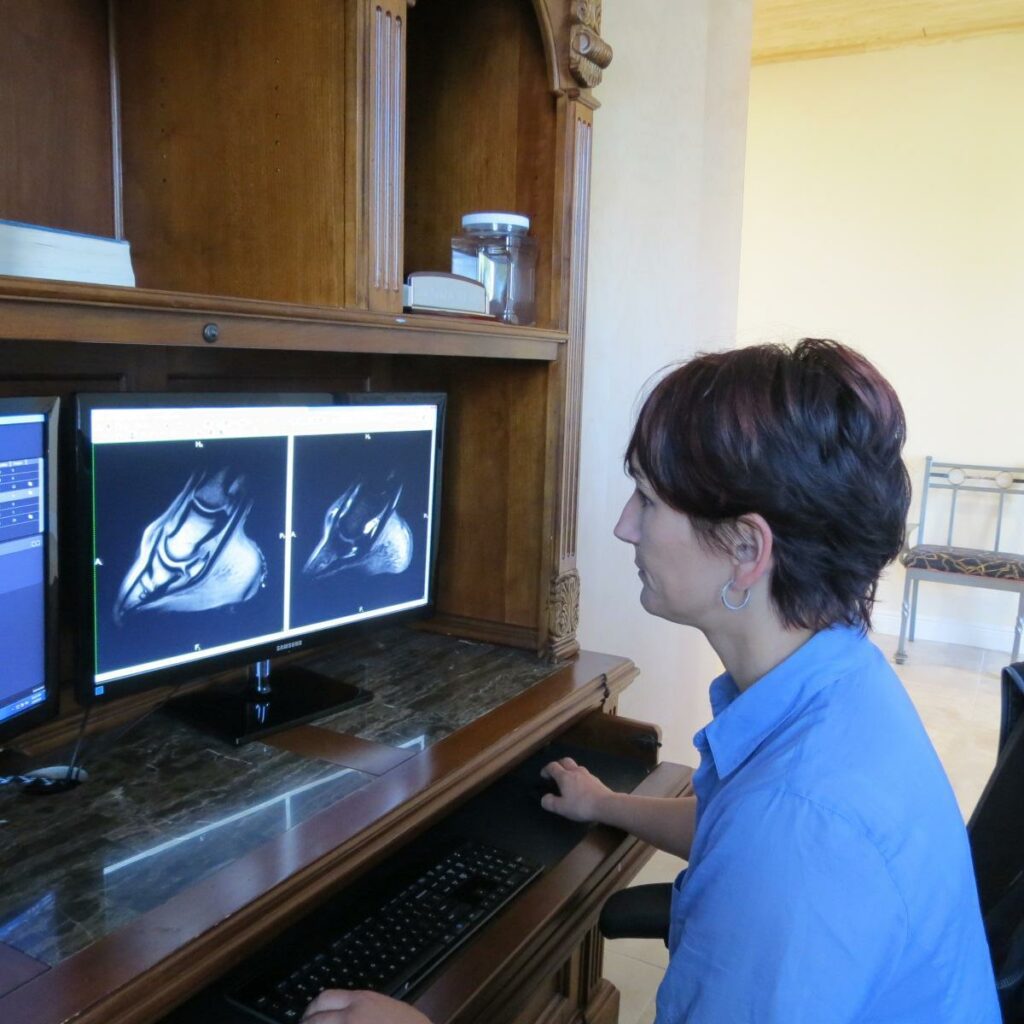
For Dr. Puchalski, the potential for future growth in diagnostic imaging services at Palm Beach Equine Clinic is huge.
“There are new technologies coming into the market for imaging all of the time and Palm Beach Equine Clinic will remain abreast of those advances,” Dr. Puchalski said. “Going forward, we are looking to acquire new equipment, and I think it is fair to say that the hospital will see an increasing role with different kinds of cases. There are a lot of changes in the market that occur very quickly, so we are always trying to figure out the best thing for this practice.”
Finding Time to Ride
In addition to working with PBEC locally and assisting veterinarians around the world, Dr. Puchalski competes her Oldenburg mare, Lucia de Luxe, in the Medium and High Amateur-Owner Jumpers.
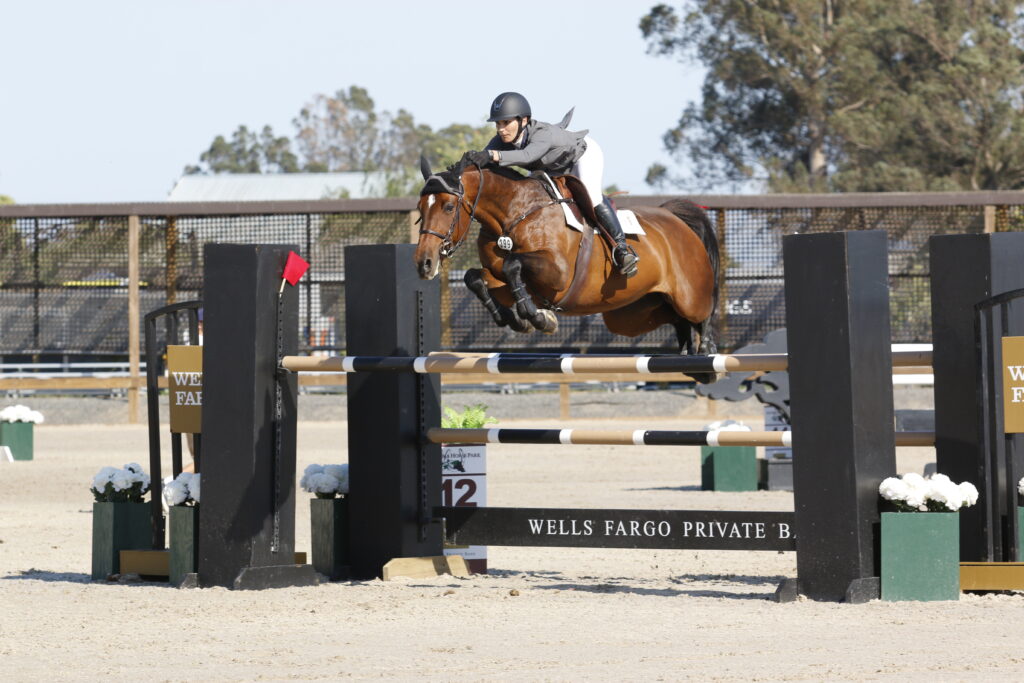
Dr. Puchalski splits her time throughout the year between her homes in California and Florida. She is based in Wellington for about five months, and enjoys competing at the Winter Equestrian Festival, for which PBEC serves as the official veterinarians.
Although her horse is currently injured, Dr. Puchalski normally rides every day and enjoys the flexibility of her job that supports her riding schedule.
“One of the best parts of what I do is the flexible schedule,” she admitted. “I try to ride every day and fit everything else around it. I can really do my job from anywhere. It can be completely web-based, which I love.”
“First thing in the morning, I check into the clinic and check on the imaging cases for the day,” Dr. Puchalski detailed. “I usually read some MRI and Nuclear Scintigraphy cases and then go ride mid-morning. Then I come back and read cases for my other clients. PBEC is a big chunk of my work, but a lot of my cases also come from global clients; I have clients all over the world.”
From a Small Town to Big Dreams
Dr. Puchalski grew up on a small-town acreage in British Columbia and started riding at a very young age. She got her first pony when she was four years old and continued riding at a three-day eventing barn next door to her home. Early on, Dr. Puchalski knew that she wanted to be a veterinarian. Dr. Puchalski graduated with a BS in Biology from Simon Fraser University in British Columbia, and completed her Doctorate of Veterinary Medicine from the University of Saskatchewan in Saskatoon. She interned in Field Service and Sports Medicine at New Bolton Center at the University of Pennsylvania, and completed her residency in Radiology at UC Davis in 2005.
During her internship at the New Bolton Center, Dr. Puchalski decided to pursue a career as a Radiologist thanks in part to one of her valued mentors, Virginia Reef, at the University of Pennsylvania.
“Dr. Reef was a huge influence on my career direction at that stage,” Dr. Puchalski noted. “Ginny was an influence in me becoming a radiologist, and then as a radiologist, I was mentored by Tim O’Brien at UC Davis – he is a founding father of equine radiology.”
Continuing to Have an Influence
Prior to joining PBEC in 2013, Dr. Puchalski spent eight years on the faculty of UC Davis providing research instruction and clinical service. Dr. Puchalski has published many scientific articles in diagnostic imaging and equine injuries which was a huge component of her early career.
“Once you have published research, the spinoff is then to publish in textbooks and other literature, so I have done a number of chapters for major lameness and diagnostic imaging textbooks as well,” Dr. Puchalski explained. “I have published more than 50 scientific articles and performed over 100 presentations all over the world on lameness diagnosis and diagnostic imaging in sport horses. I am currently trying really hard to still publish study results and be involved with universities, but also have a very busy private practice caseload.”
Outside of work and horses, Dr. Puchalski enjoys the challenges of Crossfit. In addition to her time spent in Florida and California, she also spends several weeks every summer working and showing at Spruce Meadows in Calgary, Alberta, Canada.
Dr. Puchalski is an integral part of the team at Palm Beach Equine Clinic and will continue to serve PBEC’s clientele as diagnostic imaging advances into the future.
Palm Beach Equine Clinic provides experience, knowledge, availability, and the very best care for the horses of Wellington. Have them be a part of your team! To find out more, please visit www.EquineClinic.com or call 561-793-1599. “Like” them on Facebook to follow along on what happens in Wellington and more, and get news from their Twitter!
More About Dr. Sarah Puchalski
Dr. Puchalski is a Diplomate of the American College of Veterinary Radiology whose specialty includes the interpretation of radiographs in addition to other diagnostic imaging techniques.
Dr. Puchalski is from Davis, CA, where she was an associate professor at the University of California in their Department of Surgical and Radiological Sciences. In 1995, she received her BSc in biology from Simon Fraser University in British Columbia, and in 1999 earned her Doctor of Veterinary Medicine from the University of Saskatchewan in Saskatoon, where she received the ACVS Outstanding Large Animal Surgery Student award that same year. Dr. Puchalski interned in Field Service and Sports Medicine at New Bolton Center at the University of Pennsylvania in 2001, and completed her residency in radiology at UC Davis in 2005.
Dr. Puchalski has devoted her career to teaching and improving equine health through the development and refinement of diagnostic techniques. In 2011 she contributed to two books on the topic of equine lameness. Her recent contributions include chapters in Diagnosis and Management of Lameness in the Horse edited by Ross and Dyson, as well as in Veterinary Computed Tomography and the Clinical Veterinary Advisor: The Horse, Equine Colic and Veterinary Clinics of North America. She also has contributed close to 50 scientific articles concerning the diagnosis of equine lameness to many periodic journals, including Veterinary Radiology & Ultrasound: the official journal of the American College of Veterinary Radiology and the International Veterinary Radiology Association; Veterinary Pathology; Equine Veterinary Journal; the American Journal of Veterinary Research; Equine Veterinary Education; Journal of the American Veterinary Medical Association; and Journal of Veterinary Internal Medicine.
This fall, the United States Equestrian Federation (USEF) unveiled its latest health rule requiring all horses entering a Federation-licensed competition be accompanied by documentation of Equine Influenza Virus (flu) and Equine Herpes Virus (rhinopneumonitis) vaccinations within six months of being stabled at the show. Now approaching a month of enforcement during the 2016 winter show season, the new vaccination requirements enacted by the USEF gave structure to requirements that were previously being developed and enforced on a show-by-show basis.
After Florida’s Equine Herpes (EHV) scare in February of 2013, horse show facilities began adopting vaccination requirements of their own, usually requiring EHV-1 and EHV-4 vaccines within 90 to 120 days of a horse’s arrival to the grounds.
Now, USEF specifically requires all licensed competitions comply with the same set of requirements while not increasing the workload for competition management. The six-month timeline also matches the operating procedures of international shows overseen by the FEI as well.
According to Palm Beach Equine Clinic’s own Dr. Richard Wheeler, the rule change simply makes sense.
“Most people regularly vaccinate their horses every six months anyway, so this rule should not present a disruption to current practices,” he said. “After the 2013 scare, competitions recognized the potential of closure due to infectious disease and started creating requirements which became inconsistent between shows.”
Whether directly or indirectly affected by rule change itself, an increase in awareness regarding equine infectious disease in recent years had minimized outbreaks, according to Dr. Wheeler.
“A good job is being done so far to keep a big problem away,” he added.
While efforts by the USEF, veterinarians, and horse owners alike have proved successful in keeping horses safe and healthy, Dr. Wheeler was quick to remind the equine community to not get complacent. He stresses the continuation of education and awareness.
“An increase in bio-security is the most significant benefit we’ve had as a result of these requirements,” he said. “This is the most protective measure that we have taken on as a community, and people are now cognizant of how disruptive bringing a sick horse to a show can be. We see people getting vets involved quickly and shows doing a good job of providing isolation. What’s been done in the past few years is a positive thing, but it’s important that we don’t let our guard down because we haven’t had an outbreak in a few years.”
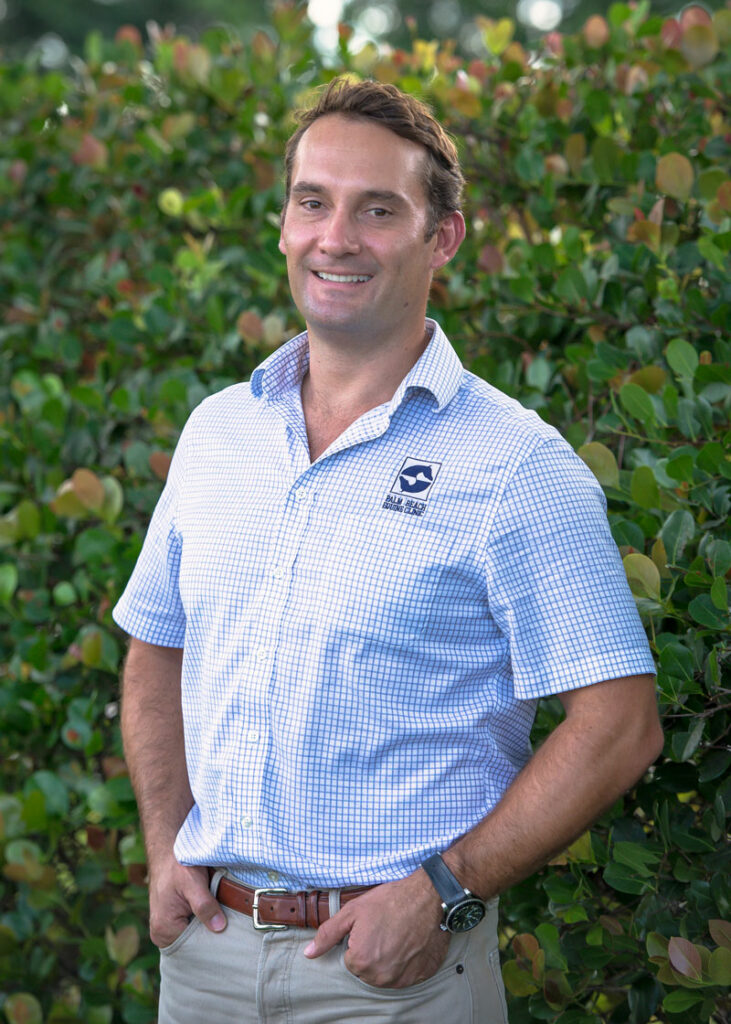

In addition to abiding by the USEF’s six-month rule, Dr. Wheeler also suggests the individuals responsible for caring for horses continue their efforts past the gates of the facility.
“Horse shows are often condensed places and limiting the exposure of horses is difficult,” he said. “It’s important that we stay really aware, take temperatures regularly, identify sick horses, and isolate them immediately. It’s all key to prevent outbreaks.”
Thanks to regulations, always improving technology, educated veterinarians, and diligent horsemen and women, the equine community is becoming more guarded against infectious disease than ever before.
To read more about the USEF vaccination requirement, click here. The experts at Palm Beach Equine Clinic stand ready to answer any questions horse owners may have about vaccinations and the requirements needed for equestrian competitions.
Palm Beach Equine Clinic (PBEC) proudly serves as the official veterinarians of the world-renowned Winter Equestrian Festival (WEF) and Adequan® Global Dressage Festival (AGDF) in Wellington, FL. Adjacent to the Palm Beach International Equestrian Center in the heart of Wellington, PBEC’s state-of-the-art facilities and world-class team of 28 veterinarians are there for every equestrian’s needs throughout the WEF and AGDF circuits. PBEC is proud to work for its multi-discipline clientele with the aid of the most advanced technologies and medical treatments available.
Official Horse Show Veterinarian
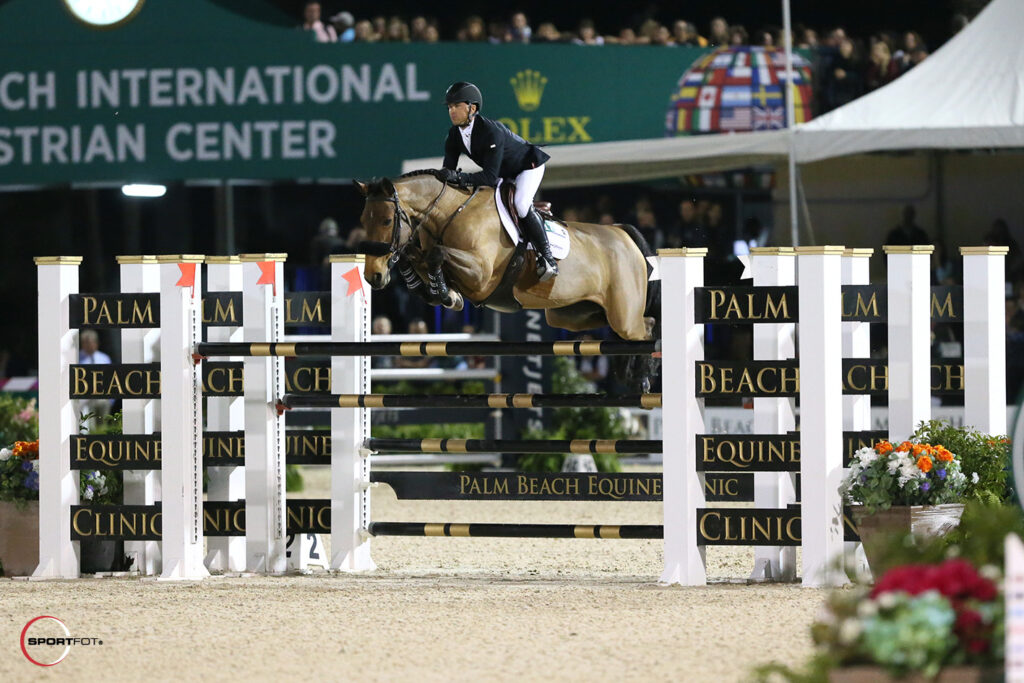
“Wellington is a fabulous place, and I have watched the growth of WEF as well as AGDF over the years, and it has been exponential,” said Dr. Scott Swerdlin, President of Palm Beach Equine Clinic. “For us to be part of that growth, and part of the explosion of the sport horse industry here in Wellington is a real honor. We want to give back to the community, as well as contribute to all of the great things that Mark Bellissimo has done for the horse show world.”
“I love to see the good horses return, and every year it seems like better and better horses are competing from all over the world,” Swerdlin added. “The quality of horses and the quality of competition always continues to improve. To watch these fabulous horse and rider combinations in all of these different disciplines is such a treat.”
Global Satellite Services
With top horses and riders from around the world spending their winters in Wellington, PBEC is proud to have veterinarians on the team that represent many different countries. PBEC currently employs veterinarians from Argentina, Uruguay, and Colombia. It is a privilege for the team at PBEC to work together with many of the best veterinarians from all over the world as they travel to Wellington with their clients.
All-Inclusive Equine Hospital
Palm Beach Equine Clinic features its full-service surgical center and intensive care hospital located only minutes from the Palm Beach International Equestrian Center show grounds. Board certified surgeons, primary care veterinarians and hospital technicians are scheduled for emergency on call assistance 24 hours a day, 365 days a year to treat, monitor and care for critical cases. With exceptional veterinarians and a staff of highly trained hospital technicians, PBEC’s surgical suite and staff are prepared to handle all kinds of emergencies, day and night.
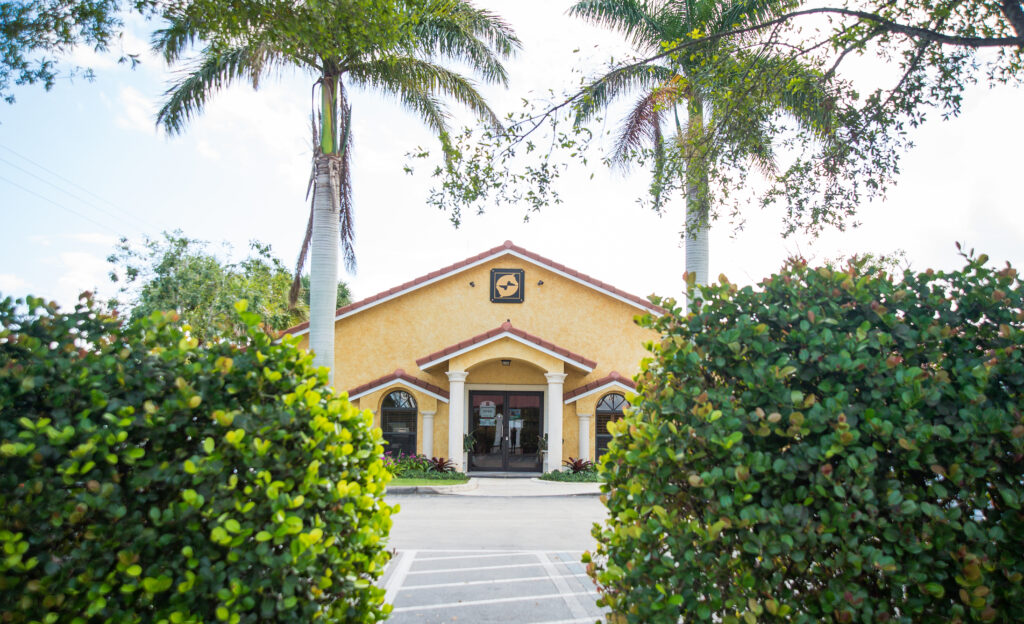
The Palm Beach Equine Clinic facility houses the most advanced imaging technologies available, including a standing Magnetic Resonance Imaging (MRI), Nuclear Scintigraphy (Bone Scan), Ultrasonography, Digital Radiography and Endoscopy. PBEC is unique in that a Board Certified Radiologist is on site to interpret images and assist with diagnosis for rapid results. PBEC’s on-site, full-service laboratory equipped with hematology, chemistry, and microbiology equipment provides veterinarians with the ability to quickly evaluate blood tests for critical cases.
The newest addition this year for PBEC is the Annex Veterinary Office located on the show grounds at the Winter Equestrian Festival. The wooden barn located at the beginning of the north grounds entrance is now an office space, pharmacy for supplies and medication pick up, and examination areas.
For more information on the facility or in case of an emergency, please call (561) 793-1599 to contact an on-call veterinarian.
Palm Beach Equine Clinic’s Dr. Richard Wheeler recently shared the basic steps he takes in performing an equine pre-purchase exam.
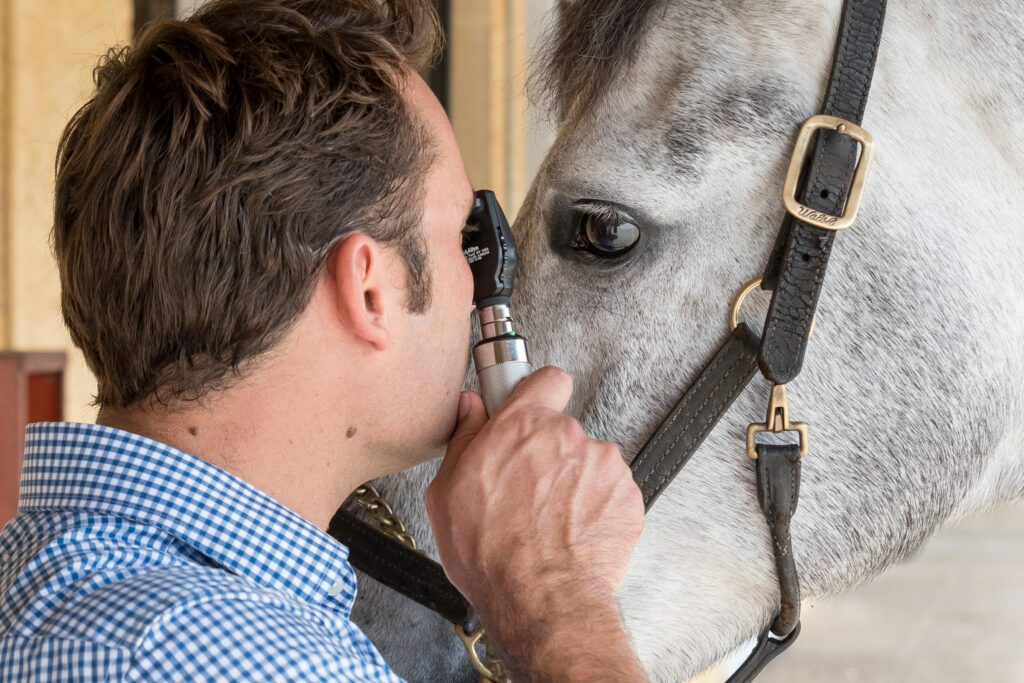
Dr. Wheeler and PBEC’s 28 veterinarians, including Board Certified surgeons, a internal medicine specialist and a radiologist, are considered some of the most experienced in treating equine athletes from all disciplines. Palm Beach Equine Clinic veterinarians enjoy the opportunity of working with top horses and riders at their home base in Wellington, FL, and through satellite services at competitions around the world.
With thousands of horses competing in Wellington at events such as the Winter Equestrian Festival and the Adequan® Global Dressage Festival, equine sales are a huge factor of equestrian businesses. Palm Beach Equine Clinic’s pre-purchase examination services are always available to assist in making the best decision on your next equine purchase.
No matter what the breed or discipline, pre-purchase exams include several basic initial steps. First, an overall health evaluation of the horse is completed, including previous health history, general condition, and conformation. The veterinarian examines specific body systems including the eyes, cardiovascular system and respiratory system.
Next, a lameness assessment is completed, including flexion tests, soft tissue structure palpation, and movement evaluation. Additional diagnostic imaging such as radiographs (x-rays), ultrasound, endoscopy, magnetic resonance imaging (MRI), or nuclear scintigraphy (bone scans) may be requested for additional information.
The goal of a pre-purchase exam is to assess its current state of the horse’s health and soundness at that time of the examination. Pre-purchase exams allow veterinarians to gather information that may help the owner and veterinarian predict a level of risk for the future use of the horse.
Steps Taken in a Pre-Purchase Exam
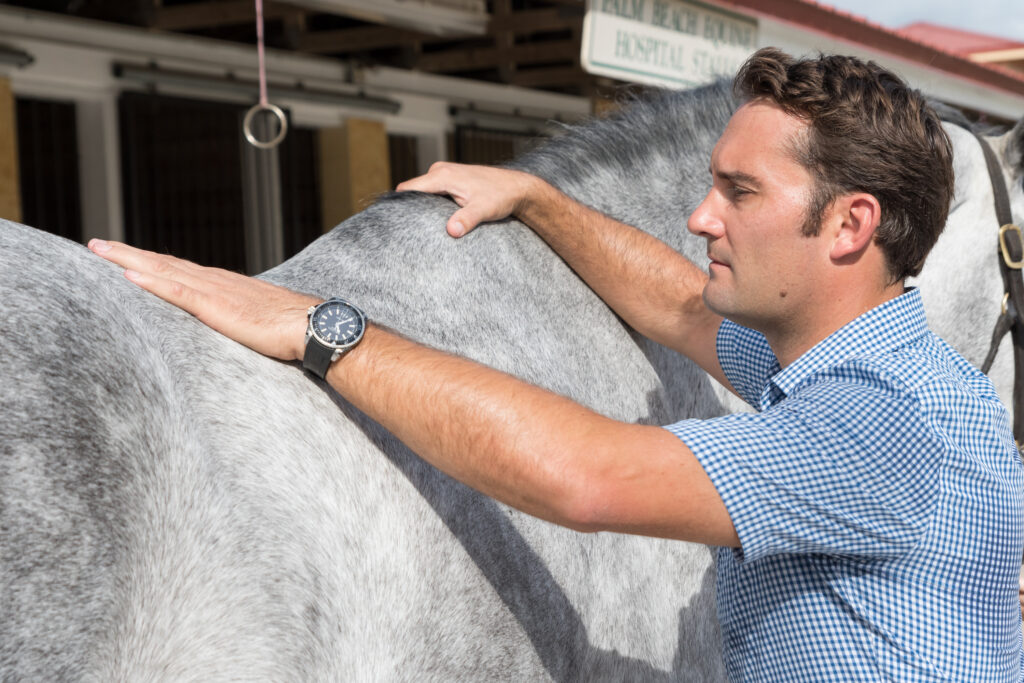
- “The first thing I do is talk to the potential buyer and trainer to gather their expectations and any concerns that have arisen during the trial of the horse. Next I discuss the horse with the current owner and/or trainer to determine what level of training or competition it is in, and if it has any previous issues that they are dealing with.”
- “Then we look at the horse in a static exam in the stall. We do a physical exam, looking at the whole body from front to back. Key points are the eyes, heart, and lungs and we palpate from the head and neck, to the back, and down the limbs. We are looking for signs of old injuries or areas that may have issues; conformation comes into play here as well.”
- “We want to look at the horse in a dynamic exam. We usually look at it on the lead line and on a lunge line, or trotting in a circle on hard and soft surfaces, and then also under saddle as well. I like to see all of my horses go under saddle because we can observe the interaction of horse and rider, which is very important. During this stage we will perform flexion tests and ask the horse to perform specific movements depending on the discipline.”
- Blood tests are often taken and normally will include CBC, Chemistry, Coggins test and a drug screen. Depending of the age or type of horse other tests may be performed.
- “Finally, there are some auxiliary tests, which may include radiographs, ultrasound exams, and endoscopy of the upper airways. These days, if there are certain issues, we will also include further diagnostic tests such as MRIs or bone scans. That depends on what is found in other parts of the exam. If there is something suspicious on a radiograph, the buyer might want to do more advanced imaging. Or sometimes, depending on the value of the horse, they might want to do that anyway.”
A Comprehensive Profile of the Horse
Dr. Wheeler pointed out that it is not the intention of a pre-purchase exam to recommend the horse for purchase or for sale. The exam is performed to provide information about the level of risk and educate the client of that risk. The client will make the decision on whether they want to buy the horse or not based on the information the veterinarian has provided as well as information from their trainer.
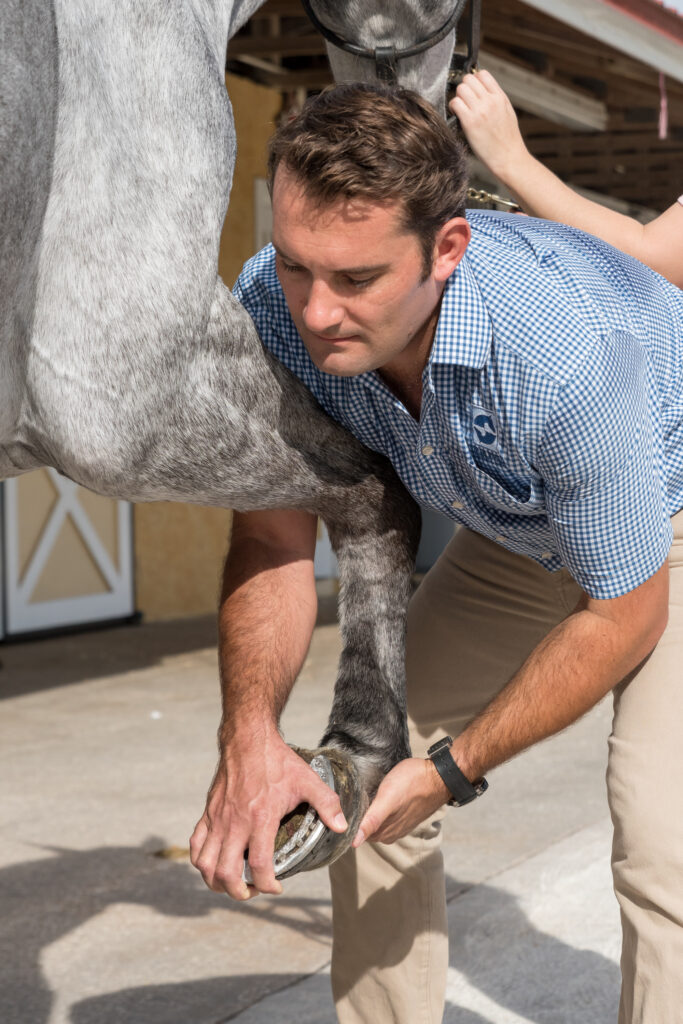
“What might be acceptable for you may not be for me, or vice versa, depending on what I want the horse for or the value of the horse,” Dr. Wheeler noted.
“It is not a pass/fail situation. We are just describing the horse, doing our best to state whether the issues that it has can be maintained or can be useful for the horse’s given profession, and what is expected of it, and this is where experience is so important. If the horse is being purchased as a low level children’s show horse, the stresses on it are going to be less than if it is being asked to go to the Olympics.”
Every exam is different, but the basic steps of evaluating a horse for any discipline or level of competition are fairly standard. It is important to have a veterinarian who is experienced and knowledgeable with the specific discipline to provide accurate guidance on the horse’s condition for the expected job. For the clientele of Palm Beach Equine Clinic, the veterinarians are all well-schooled in the different disciplines, and many have additional expertise in specific areas.
The world-renowned veterinarians of PBEC will be sharing their expertise on equine pre-purchase exams in a four-part series featured exclusively on ProEquest from February through April 2016. Located in the heart of Wellington, FL, Palm Beach Equine Clinic serves multi-discipline clientele at equestrian competitions throughout North America and abroad. To schedule a pre-purchase exam with one of Palm Beach Equine Clinic’s top veterinarians call 561-793-1599.
About Dr. Richard Wheeler

Dr. Wheeler graduated from the Royal Veterinary College in London in 2002. He spent his first two years of practice as an intern at Greenwood, Ellis and Partners in Newmarket, England, where he worked in a referral center specializing in the treatment of Thoroughbred racehorses and Sport Horses. Dr. Wheeler moved to Palm Beach Equine Clinic in 2005 and became a partner in 2009. Dr. Wheeler’s clients include Jumpers, Dressage and Polo and he is licensed to practice in FL, KY, NC and NY and also the UK and Europe.
Equine Internships and Externships for Veterinary Students and Graduates
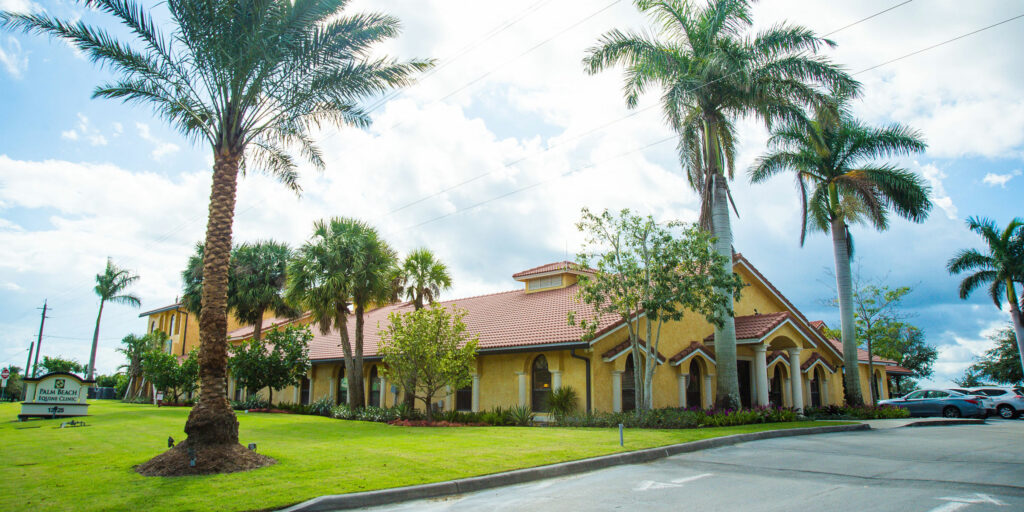
While Palm Beach Equine Clinic may be known for the 28 superb veterinarians who call it home, they are also a driving force in educating the next generation of equine medical professionals. Through world-renowned equine internship and externship programs, Palm Beach Equine Clinic molds new veterinarians every day.
Each year, equine interns work with Palm Beach Equine Clinic veterinarians for a 12-month period. Whether from externships that usually last up to two weeks and serve as an introduction to the practice or by references from top veterinarians across the U.S. and abroad, Palm Beach Equine Clinic attracts the most promising young veterinarians in the field.
Educating Equine Veterinary Students and Graduates From Around the World
Currently, Palm Beach Equine Clinic is host to recently graduated veterinary students from Oklahoma, Scotland, and Argentina. According to Palm Beach Equine Clinic veterinarian and board-certified surgeon Dr. Weston Davis who leads the Internship program, South Florida attracts only the best.
“We really have the cream of the crop because they have big opportunities here,” said Dr. Davis. “A lot of equine internships can offer work with one or two veterinarians, but what’s cool at Palm Beach Equine Clinic is they can pick from the collection of doctors we have.”
Palm Beach Equine Clinic interns rotate through three phases, including hands-on application of hospital anesthetization, imaging – both from ambulatory duty and elective – and working with a doctor of their choice based on their specific interests.

Dr. Davis has been with Palm Beach Equine Clinic for two years and immediately took interest in making the equine internship program the best it could be. In two years, he has made one of the world’s best programs even better.
Benefits of an Equine Internship
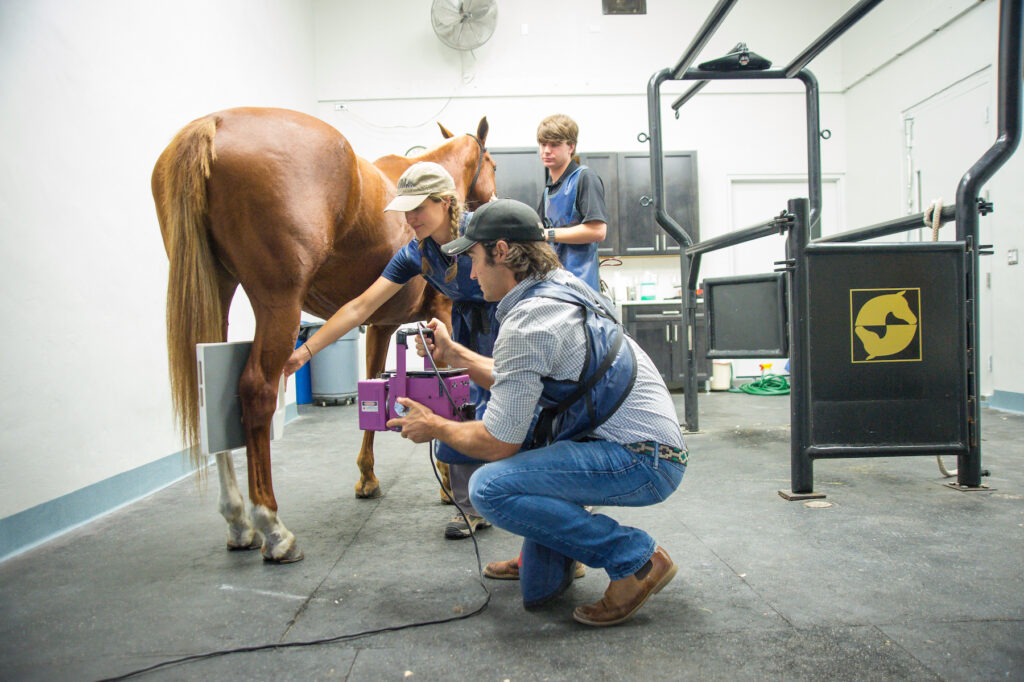
“I wanted to make it as organized and structured as it could be so they can get as much out of that year as possible,” he said. “The general rule is that doing a one-year equine internship puts you three to five years ahead of those that come out of school and start out on their own. Interns come out of school with a handle on book knowledge and the internships give them a good clinical appreciation for those same topics. They see a lot and do a lot under the supervision of seasoned veterinarians while they are here.”
While Palm Beach Equine internships offer obvious perks for the interns themselves, it also has added benefit for the veterinarians already at the clinic.
“The value for the interns is they get to see a tremendous amount of cases in short time, but it’s also valuable for us because they come out of school with fresh knowledge, new ideas, and keep us current and on our toes,” said Dr. Davis.
Traditionally veterinary students will fulfill their equine internship requirements and move on to find a full-time position at other practices. Dr. Davis himself did just that after graduating from the University of Florida College Of Veterinary Medicine and interning at Oakridge Equine Hospital in Oklahoma. But, the experiences available at Palm Beach Equine Clinic keep its interns staying put.
Equine Internships Kickstart Veterinary Careers
History has proven that many interns who work for Palm Beach Equine Clinic as interns go on to accept full-time positions at the clinic. One of those veterinarians is Dr. Ryan Lukens. After earning his DVM from The Ohio State University College of Veterinary Medicine, he began an internship with Palm Beach Equine Clinic in 2012.
“I am so pleased that I did my internship with Palm Beach Equine,” said Dr. Lukens. “It was basically another year of school where I got to focus on exactly what I wanted to do.”
Dr. Lukens specialized in sports medicine, lameness, and diagnostic imaging, which is a passion he inherited from his father, a fellow veterinarian. His experience with Palm Beach Equine Clinic solidified that concentration thanks to the latest in veterinary technology.
“When I came to Palm Beach Equine Clinic, I had access to all the newest equipment. That gave me more tools to improve my skills under the direction of a full network of senior veterinarians,” added Dr. Lukens. “When you leave vet school, you have a question every hour of the day, and I had a number of veterinarians who were a phone call away to answer those questions. I never had to second-guess myself because they were there to help me learn. But, there also isn’t always one way to do something correctly. I learned the opinions of so many veterinarians who do things just a little differently, and it helped me to find my own way and what’s best for the horses I treat.”

Thanks to Palm Beach Equine Clinic, horse owners in South Florida and beyond have access to well-educated veterinarians with hands-on experience that is unmatched.
Interested in Applying for an Equine Internship?
Fill out this form to get in contact with the internship and externship department.
Palm Beach Equine Clinic is renowned for its full-service surgical center and intensive care hospital located in the heart of Wellington, Florida. Board certified surgeons, primary care veterinarians and hospital technicians are scheduled 24 hours a day, 365 days a year to treat, monitor and care for critical cases. With world class veterinarians and a full staff of highly trained technicians, both clients and patients of Palm Beach Equine Clinic are in the best hands possible.
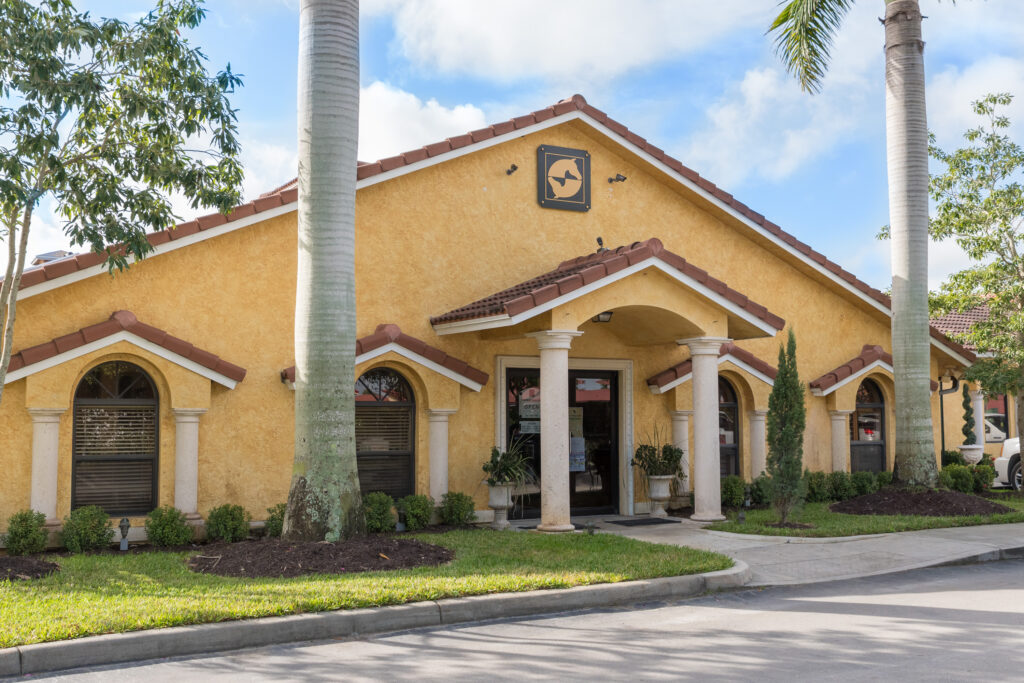
Equine Hospital and Surgical Facility
Palm Beach Equine Clinic’s surgical suite and staff is prepared to handle all kinds of emergencies, day and night. The large team of 26 veterinarians includes three Board Certified Surgeons who rotate on-call duties for all emergencies. This aids Palm Beach Equine Clinic veterinarians and all of the Southeast with the ability to treat their emergencies quickly, especially any requiring surgical assistance. The state of the art intensive care hospital is equipped with digital video cameras for the clinicians to easily monitor their patients from any location, at any time. Palm Beach Equine Clinic also has a full-service laboratory on-site equipped with hematology, chemistry, and microbiology equipment to internally evaluate each case and provide rapid results.
Advanced Diagnostic Imaging Capabilities
Palm Beach Equine Clinic prides itself as a consistent leader in horse sport medicine and recently upgraded its scanning technologies to provide better equine diagnostic imaging services for their clients.
Last fall, Palm Beach Equine Clinic installed a state-of-the-art MRI lab containing the Equine Standing MRI manufactured by Hallmarq, which allows scans of the equine foot and lower limb to be done in a standing position requiring only light sedation. Additionally, last year Palm Beach Equine Clinic completed the renovation of a Nuclear Scintigraphy lab with the installation of the new top of-the-line MiE Equine Nuclear Scintigraphy camera. This new gamma ray camera is designed with sharper contours for more precise imaging and lameness diagnosis. The advanced technology provides the ability to acquire high quality images regardless of small patient movements, alleviating the necessity for re-scans and reduces the time required to complete a scan. Both MRI and Nuclear Scintigraphy can be extremely useful in diagnosing lameness origins and determining appropriate, effective treatment for your horse. Palm Beach Equine Clinic has a Board Certified Radiologist on site to interpret images to assist with diagnosis.
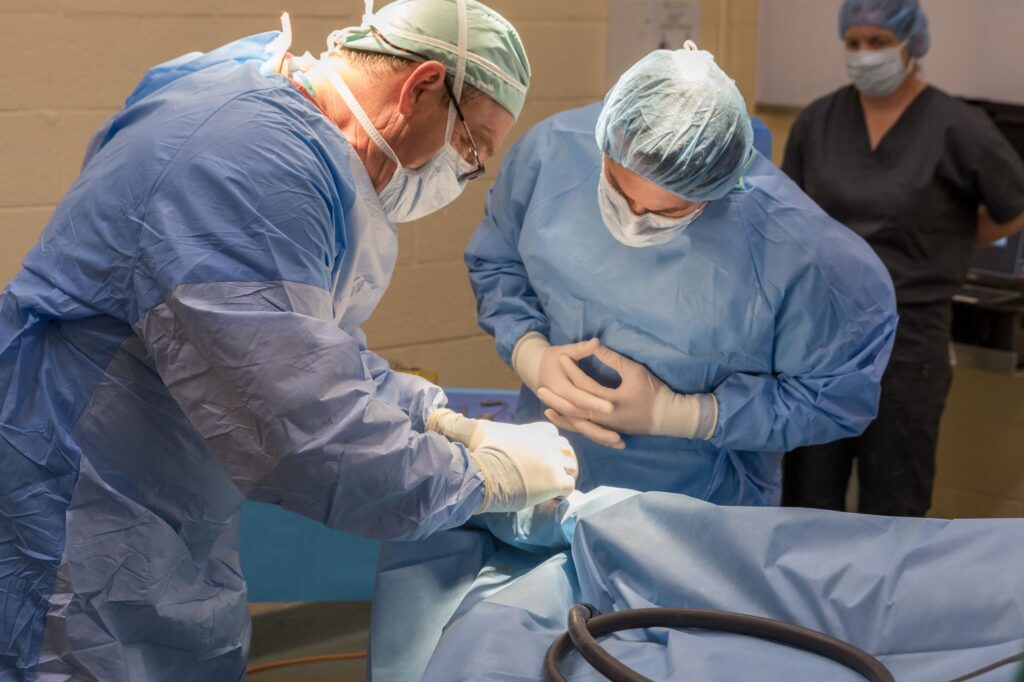

For Palm Beach Equine Clinic, 2016 will be an exciting year for expansion of our physical facility. PBEC plans on adding an additional 4,000 square feet of air conditioned examination areas, an additional surgical suite and recovery stall, as well as, climate controlled isolation quarantine stalls. Under the guidance of Dr. Sarah Puchalski, our in house Board Certified Radiologist, Palm Beach Equine Clinic hopes to add the first equine Computed Tomography service (CT scans) to our diagnostic imaging expertise.
Consult Palm Beach Equine Clinic for your Horse Health Needs
For more information on our facility or in case of an emergency, please call (561) 793-1599 to contact an on-call veterinarian.
Learn More About Surgeon Dr. Weston Davis
Dr. Weston Davis is a second-generation veterinarian from South Florida. His father is recently retired from veterinary medicine and his family raises beef cattle in Clewiston, FL. Dr. Davis graduated Magna Cum Laude from the University of Florida College Of Veterinary Medicine in 2008. He was awarded the Barbaro Gulfstream Scholarship (a veterinary scholarship named in honor of the amazing Barbaro), the Calder Race Course Scholarship, and the Student Award for Excellence in Large Animal Surgery.
After graduation, Dr. Davis completed his internship in Sports Medicine and Surgery at Oakridge Equine Hospital, followed by a residency in Equine Surgery at North Carolina State University. In 2012, he became board certified in Large Animal Surgery by the American College of Veterinary Surgeons. Before joining Palm Beach Equine Clinic, Dr. Davis spent 1.5 years as a staff surgeon at a private practice referral center in Texas. He has authored and co-authored publications on topics ranging from colic surgery to advanced imaging and novel surgical techniques. In 2014, he was awarded the BEVA Trust Peter Rossdale EVJ Open Award for a research publication on return to performance following colic surgery. He has spoken at several national and state meetings.
Dr. Davis is an avid sportsman himself, and his hobbies include fishing, hunting, waterskiing and almost any outdoor activity.
Tell us more about your background with horses growing up?
I started riding horses when I was so young I can’t remember. We had some amazingly kind horses that packed us around and took care of us (and a couple that didn’t). Riding as a child was mostly business – for the purpose of working cows. Somewhere around 14, I began team roping for pleasure and competition. I roped throughout college, but lost the required free time when I began practicing veterinary medicine. I’ll probably get after it again when I am retired and much too old to be doing that sort of thing!
When and why did you decide to become a veterinarian and why did you choose to pursue a career in surgery?
I decided to be a veterinarian very early in life.I had a father and uncle who were both successful and happy veterinarians whom I looked up to, so it was a logical path to follow. The surgical interests started as a kid watching my father do surgery, something I always thought was amazing and he was very skilled at. My decision to pursue the surgical avenue came during vet school when I realized that I wanted to specialize and knew surgery was my passion.
What is the best advice that your father has given you as a veterinarian?
My father is a man of few words. However, by watching him, I learned one of the biggest life lessons, which is to be calm and content with your career and your life.
What do you enjoy about speaking publicly and sharing your knowledge?
I think mentoring, sharing knowledge and teaching the hands-on skills to the next generation of veterinarians is one of the most fun and rewarding parts of my job. Observing a student as content and excelling in their career with a skill set that you contributed to, even in a small way, is a beautiful thing.
What is the most interesting or rewarding surgical case you have worked on?
Although minimally invasive arthroscopic type surgeries are my favorite to perform, I think colic surgeries are one of the most rewarding. They are often difficult surgeries and inevitably in the middle of the night, but you take a horse who would most certainly die without you, and save a life. Helping a horse who was in excruciating pain or has a life-threatening devitalized piece of intestine recover back to feeling comfortable and eating in their stall the next day is about as good as it gets.
What are your goals for your career now?
My goal is to expand the surgical and outpatient sports medicine referrals at PBEC. I am currently the coordinator for the intern and resident program. I plan to expand and improve on the quality of these mentoring programs within the industry. I am also working on the development and description of some novel minimally invasive surgical techniques. I aim to continue authoring 1-2 publications annually in the refereed equine literature.
When not roping, fishing, hunting or water-skiing, what other things do you do with your free time?
Most of my non-equine time lately has been devoted to some real-estate interests and house renovations. I am also a big reader.
Palm Beach Equine Clinic is proud to be the Florida distributor of DJM Sole Supports. DJM Sole Supports can safely be used to give instant relief for many common hoof ailments in horses. They are especially helpful for horses suffering from laminitis, punctured soles, infections, foot abscess, pre- or post-surgery support, foot and heel soreness, sole pressure related issues, barefoot trims and extra support to travel long distances.
Facts about DJM Sole Supports
DJM Sole Supports are 100% breathable, easy to apply and provide instantaneous relief due to uniform support for the entire foot. The supports can be used in conjunction with any medicated gel to help an injury or infection. Once the pad has formed its shape, it will not alter.

The supports can be washed in warm salty water, allowed to dry naturally and reused for up to two weeks. The pads can also be left on for several days at a time. However, if there is a discharging wound, the pad should be removed, cleaned thoroughly and reapplied every 24 hours.
The DJM Sole Support engineering was developed by farrier David Mangan, who now solely devotes his time and knowledge into designing innovative products for horses. The Sole Support is unique and superior to other products due to its patented composition. When a horse’s foot is sore and inflamed, the sensitive laminae swells, causing pain from any load or movement. The DJM Sole Support aids in reducing the sole’s movement, evenly distributes the pressure and minimizes the downward movement of the sole from loading.
Proper Application of a DJM Sole Support
Proper application of a DJM Sole Support will give rapid relief to the horse in a majority of cases. In the case of Laminitic horses, DJM Sole Supports can provide relief by supporting the sole to reduce the pull of sensitive inflammatory tissues (Laminae) as it separates from the hoof wall. Sole Supports can also offer full protection and comfort while travelling long distances by trailer or plane. Horses that are preparing or recovering from surgical procedures can benefit from the use of Sole Supports to reduce the loading on supporting limbs and stabilize the injured leg. In cases where horses suffer from corns or stone bruises, the Sole Support can reduce inflammation, provide protection and comfort with, or without, a shoe. The supports will also give instant relief to horses that are sensitive to shoeing and typically require a few days to recover. The sole supports are an excellent, clean alternative to “hoof packing” after a hard day’s work. Additionally, for horses that have lost a shoe and rely heavily on those shoes for soundness, the Sole Support may be used to protect the foot while waiting for the farrier to arrive.
DJM Sole Support pads are available in three sizes to fit most horses.
If the pad is larger than the foot, it is safe to allow excess to cover the heels and or provide a rolled toe. The support pads are available in either “soft” or “firm” types, with the softer compound more suitable for the very tender footed horse.
Always on the forefront of medical advances, Palm Beach Equine Clinic is proud to distribute DJM Sole Supports in Florida. For more information, please visit https://paniolo.online/product/sole-support/ or call the experts at Palm Beach Equine Clinic at 561-793-1599.
The Growth of Palm Beach Equine Clinic
Jump Media interviewed Dr. Scott Swerdlin, DVM, MRCVS, and President of Palm Beach Equine Clinic to learn more about the Clinic’s simple beginnings and evolution into one of the largest veterinary practices in the United States.
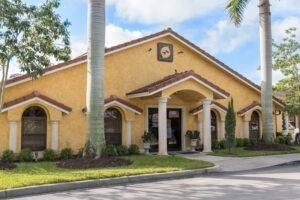
What was the genesis of Palm Beach Equine Clinic? Why was it started, how big was it, how many vets worked in the beginning, what kinds of services were offered?
In 1979, Dr. Paul Wollenman came to Wellington, Florida to principally care for Lion Country Safari’s exotic animals. Dr. Wollenman started to build the physical structure of Palm Beach Equine Clinic in 1981. I joined PBEC in 1983 and it was the beginning of a remarkable partnership. Mine and Dr. Wollenman’s strengths complemented each other well. I had recently resigned my Captaincy in the United States Airforce Veterinary Core and was excited to come back to where I grew up.
In 1991, we enticed Dr. Robert W. Brusie to join us from his successful surgical practice in Atlanta, GA. Dr. Brusie joined us to build the modern foundation of Palm Beach Equine Clinic. I was extremely fortunate to have these two extraordinary veterinarians as mentors. Shortly after Dr. Brusie joined us, we had an exceptional surgical service routinely treating colic cases and performing orthopedic surgeries. The final piece of the puzzle was to bring on a remarkable veterinarian from the next generation. We found that missing piece in 2003, when Dr. Richard Wheeler joined the team.
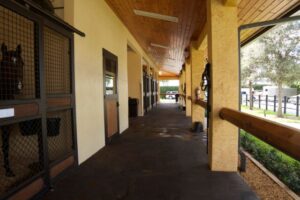
When did PBEC evolve into its current state?
The evolution of Palm Beach Equine Clinic has been constant and ever increasing. The growth of Palm Beach Equine Clinic mirrored the growth of the show horse industry through 2005. Ten years ago, we witnessed an exponential growth in the dressage discipline. From our simple beginnings, we now have twenty-eight veterinarians. What I take great pride in is my job is to keep twenty-eight veterinarians happy and explore additional opportunities to continue to grow and improve. Almost 30 years ago, Palm Beach Equine Clinic bought the first ultrasound for equine practice in South Florida. Twenty-five years ago, Palm Beach Equine Clinic installed the first gamma-ray camera to perform bone scans (Nuclear Scintigraphy). Twenty years ago, we developed Computed Radiography (CR) for horses. Currently, Palm Beach Equine Clinic has the most advanced state-of-the-art surgical and diagnostic imaging equipment for the horse. Onsite, we have a Hallmarq standing MRI unit, MiE gamma ray camera, Digital Radiography, Video Endoscopy, and a bevy of additional diagnostic equipment. Palm Beach Equine Clinic is dedicated to providing exceptional veterinary service for the horse.
What are the most important parts of PBEC?
No question, it is our staff. Palm Beach Equine Clinic is dedicated to providing a culture of respect and excellent communication. Palm Beach Equine Clinic encourages every technician and employee to embrace their position not just as a job, but as a career. Many of our technicians and administration staff have been a part of Palm Beach Equine Clinic for over 10 years. I want every person who works here to feel as though they are part of a team. Unequivocally, the most important part of Palm Beach Equine Clinic is its family of employees.
How was PBEC changed in the past several years?
Over ten years ago, we were fortunate to have Dr. Bill Patterson, Dr. Gary Priest, Dr. Bob Smith, Dr. Hilary Clayton, Dr. Jordan Lewis, and Dr. Kathleen Timmins join Palm Beach Equine Clinic to contribute to the culture and the success that we currently enjoy. In the past several years, we have added multiple, additional extraordinarily talented veterinarians. Dr. Jorge Gomez, Dr. Weston Davis, Dr. Sarah Puchalski, Dr. Bryan Dubynsky, Dr. Janet Greenfield, Dr. Tyler Davis, Dr. Daren Tamplin, Dr. Natalia Novoa, Dr. Ryan Lukens, Dr. Selina Passante-Watt, and Dr. Sarah Allendorf have all recently joined the Palm Beach Equine Clinic team within the past five years. We have updated all of our technical capabilities and we have added an Annex Office on the WEF show grounds in Wellington, Florida.
What do you see PBEC adding in 2016?
For Palm Beach Equine Clinic, 2016 will be an exciting year for expansion of our physical facility. Palm Beach Equine Clinic plans on adding an additional 4,000 square feet of air conditioned examination areas, an additional surgical suite and recovery stall, as well as climate controlled isolation quarantine stalls. Under the guidance of Dr. Sarah Puchalski, our in house Board Certified Radiologist, Palm Beach Equine Clinic hopes to add the first equine Computed Tomography service (CT scans) to our diagnostic imaging expertise.
Is there anything else you would like to add?
Palm Beach Equine Clinic owes all of its success to the horsemen and horsewomen of South Florida. We thank you for trusting our Doctors and staff with your precious family member, your horse. PBEC Veterinarians volunteer their time for many projects in our community. It is our pleasure to support Vinceremos Therapeutic Riding Center, Charity Challenge, One World, and many other local charities. Our doctors also contribute their time to providing veterinary care for the Winter Equestrian Festival and Global Dressage Festival as the Official Veterinarians. Palm Beach Equine Clinic is dedicated to providing exceptional care to your horse and is committed to improving our relationship with our clients, as well as our community.
Meet Dr. Janet Greenfield-Davis
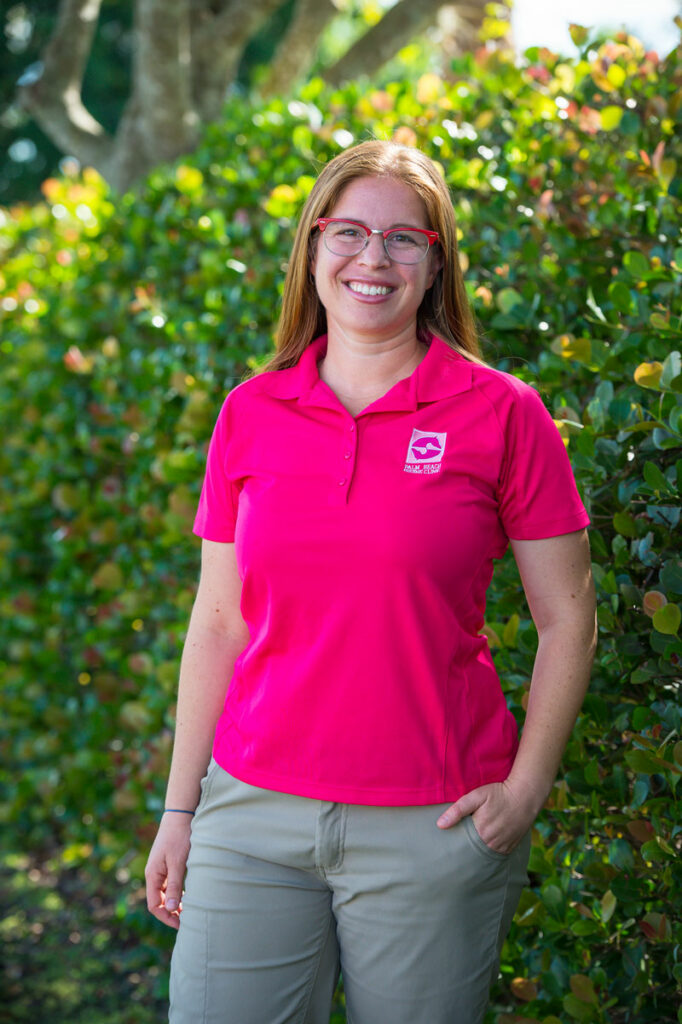
Dr. Janet Greenfield-Davis knew she wanted to be a veterinarian since elementary school. She grew up riding and competing on the hunter/jumper circuit in California before attending California Polytechnic State University and graduating from the University of Glasgow School of Veterinary Medicine in Glasgow, Scotland. Working alongside her husband Tyler Davis, Janet joined the Palm Beach Equine team as an intern before accepting a full-time position in 2010.
What inspired you to be a veterinarian?
I started riding at eight years old in a little field at the end of my street. As I started to grow up, my dad got me taking lessons and competing. He asked me one day when I was 11, ‘What do you want to be when you grow up’? I told him that I wanted to be a veterinarian and work on horses. He never let me forget that, so I grew up and became a veterinarian.
What is it like to work with your husband every day?
It’s wonderful. How many people can say that they get to see their significant other throughout the day, work on cases together, and bounce ideas off each other? We have worked together since the day we met. We went to school together, sat together in class and now we work together. I absolutely love it.
Have your children inherited the animal-lover gene?
Oh yes! We have two girls – Zella is two and Maisie is five months. Zella comes on calls with me regularly. She has her own toy stethoscope in my truck.
What is your specialty?
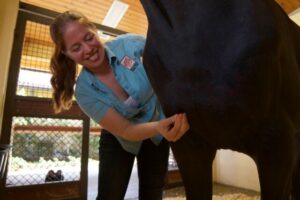
I specialize in acupuncture and herbal medicine. Both piqued my interest in vet school, and when I came to Palm Beach Equine, there was an opening for an acupuncturist. I really love having a way to treat animals without using drugs or steroids. It’s one more method to help equine athletes reach peak performance and is gaining more and more popularity. When I first started, people didn’t embrace it as much, but now even more doctors are starting to turn to it for cases they are not sure how to diagnose. With all the strict rules in FEI, it is a way to make a horse feel better without using drugs.
When you are not working, where can we find you?
Hanging out with my kids and my husband. We try to do family things as often as we can.
What advice would you give to someone considering vet school?
It’s a long, hard road but if you love it, it is so worth it.
What do you like about being on the Palm Beach Equine team?
We have all the diagnostic equipment we could ever need, and I love the quality of practitioners that we have at our practice. We always work as a team – everyone’s number-one goal is the best care for horses and animals in general.
Name one thing most people don’t know about you?
I used to swing dance. I taught lessons and performed for a long time.
